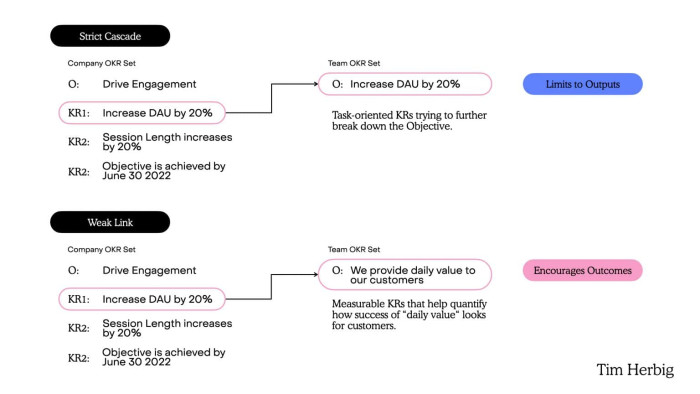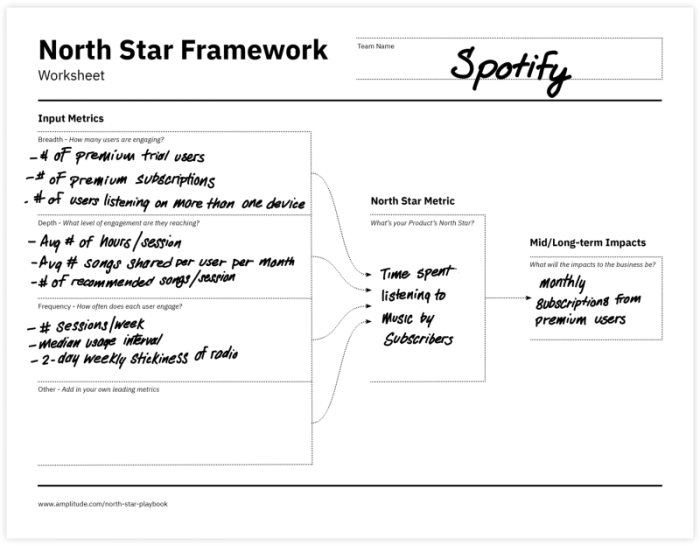If you find yourself (and your team) stretched in so many different directions without clear goals and ways to achieve them, it’s time to take a step back. Revisit your product strategy and make sure that the goals you’ve set are realistic, measurable, and aligned with the product vision.
You can start by assessing the current state:
Where are you now? Where do you want to be?
When you have the answer, start thinking of concrete tasks and activities that will help you get where you want to go. You need to articulate the exact aim of your activities before you start working on them. This applies to both short-term and long-term goals you set.
Here are the goal-setting frameworks that will help you gain clarity, certainty, and confidence to start taking action towards growth.
In this chapter
SMART Goals
SMART stands for making your goals Specific, Measurable, Achievable, Relevant, and Time-bound. Let’s break this down.
Specific: Define exactly what you want to achieve, who’s responsible for it, and what tasks need to be completed. Be as specific as possible. Because, without the specifics, you risk having vague goals that are hard to achieve.
Measurable: Make sure to identify a measurable outcome for each goal and have a clear definition of success. This will help you evaluate achievements and track progress. If you can’t measure it, you won’t be able to know whether you succeeded.
Achievable: Outline the steps your team needs to take to reach the goals and make sure they’re realistic and reasonable. There are inevitably going to be challenges along the way, so ensure that the potential roadblocks are known up-front.
Relevant: Keep your product vision in mind and define the goals that are going to be worth the effort. For each of the goals you set, know the answer to why those specific goals are important.
Time-bound: Make a time frame for every goal. Set the start and finish dates, so that everyone on your team can stay on track. Otherwise, you risk your team being discouraged. Also, put in the check-up dates to revisit goals as you go and evaluate whether you should iterate.
Summing up, SMART goals can result in a sentence like this:
Our goal is to [quantifiable objective] by [deadline]. [Team members] will accomplish this goal by [steps they’ll take to achieve the goal]. Accomplishing this goal will help us [result or benefit].
OKRs
OKR stands for Objectives and Key Results. This goal-setting framework helps teams establish clearly defined objectives as goals, and then break down the goals into relevant and measurable key results and milestones to track the progress.
The OKR framework was originally created at Intel and then adapted by Google, Twitter, Netflix, and other tech companies.
Due to its “cascading” nature from company-level goals to department-level execution, OKRs are often compared to and/or used with the Waterfall development methodology. Therefore, this approach is more likely to be adopted by an enterprise-level company.
As Tim Herbig, product management coach, explains in his comprehensive guide to using OKRs in product management there is a certain “danger in ‘trickling down’ key results throughout cascades”.
His advice to avoid such danger includes using co-called weak links instead of strict cascades:
“Reduce the number of cascades as much as possible. Though company-level OKR sets can provide crucial guidance, department OKRs rarely do and, instead, only limit the Product team to focus on outputs, not outcomes.
Weak links, not strong ties: While a company or department-level OKRs are a relevant input for the OKR definition, there’s a common myth that any Key Results of a higher-level OKR set need to be synonymous with the Objectives of the team’s OKR sets.”
– Tim Herbig, product management coach and consultant
And here is the visual representation of Herbig’s explanation that strict OKR cascades lead to output focus, while weak links encourage outcomes:

(Source; © Tim Herbig)
KPIs
KPI stands for Key Performance Indicators. These are the quantifiable metrics used to determine strategic, financial, and operational business performance in the long term. The KPIs framework typically revolves around the set of goals, targets, and industry benchmarks.
Types of KPIs are:
Customer-focused: Including customer lifetime value (LTV), customer acquisition cost (CAC), customer satisfaction score (CSAT), customer effort score (CES), and Net Promoter Score (NPS), as well as customer experience and customer retention.
Process-focused: Including operational performance metrics, business intelligence, and product analytics
Financially-focused: Including monthly recurring revenue (MRR), annually recurring revenue (ARR), gross profit margin, the bottom line, and more.
Unlike OKRs, the KPIs are widely used by SaaS companies, startups, and small businesses.
North Star Framework
At the heart of the North Star framework lies the North Star Metric – a single, most important metric used to predict growth on the product-led path to success. Think of it as a guiding star. Every goal you set needs to be aligned with your North Star Metric, as the main KPI.
Depending on your team structure, product lifecycle stage, and other factors, your North Star Metric will vary, but it should always be unique to your business, representing your product vision and mission.
Note: The North Star Metric isn’t something that you only choose once. As your company grows and your product moves closer to the product vision, the most crucial metric for your business will evolve and change accordingly.
To help product teams implement this framework more easily, Amplitude has put together the North Star Playbook. Use it as a guide to define your hypothesis, identify the right inputs and tests, and focus on a clear understanding of the outcome you want to achieve.
You can also download the North Star Worksheet from Amplitude to use in your team workshops. Here’s an example of how the completed worksheet looks like for Spotify:

(Source; © Amplitude)
All in all, keep in mind that your North Star Metric needs to be a leading indicator of future success. It should also be well-defined, immediately understandable to everyone on your team, and actionable.
HEART Framework
When you set your goals, you can use the HEART framework for measuring success.
Google has developed the HEART framework since “new challenges and opportunities for measurement of user experience on a large scale have been identified”.
As Google describes it, HEART is the framework for user-centered metrics, as well as a process for mapping product goals to metrics. This can help your product team make decisions that are both data-driven and user-centered.
HEART stands for:
Happiness
Engagement
Adoption
Retention
Task success
Using the HEART framework can be a great way to evaluate goals and measure user experience, from a single feature adoption to overall customer satisfaction with your product. Google also encourages teams to conduct more research based on large-scale behavioral data.
And, along with product analytics, we encourage you to use Microsurveys to continuously collect user feedback and make your product more customer-centric as you go.

On-Demand Webinar: How to Use Microsurveys
Equip your team with a modern approach to user feedback that powers product development ⚡




